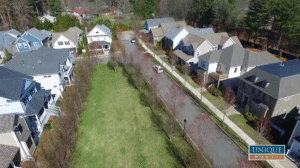
The Olde Village Square condominium neighborhood packs 40 single-family and townhouse units onto a 6.63-acre parcel a short distance from Medfield’s town center. Image courtesy of Unique Homes of Medfield
Home prices and rents have never been so high, nor has affordability ever been so low, thanks to decades of underbuilding.
And the Bay State’s plans to rein in these skyrocketing costs can be summed up in three words: build more housing.
Yet there is a large gap in the state’s master plan for making housing affordable again. In fact, it is a gap that is big enough to slip through a suburban Colonial or Ranch of the type once popular in the decades after World War II.
Why the Multifamily Focus?
While governors for the past two decades have banged the housing production drum, the Healey administration has put the issue front and center in a way that it wasn’t before.
That certainly makes sense given the median price of a home in Greater Boston now approaching $1 million, and the housing crisis has gone from bad to worse to catastrophic.
But one thing that hasn’t changed, even as the governor has put the housing mess center stage, is the almost exclusive focus on spurring construction of new apartments and condominiums, with little if any attention paid to single-family homes.
Healey is just the latest in a long line of governors who have paid little service, if that, to the shortage not just of multifamily housing, but of the now old-fashioned single-family home built to be affordable for a middle-class family.
The MBTA Communities Act, which is the administration’s main focus right now when it comes to boosting housing production, is designed to force cities and towns to open their doors to new multifamily housing.
While on a much grander scale, the 2021 law, in its focus on spurring new apartment and to some extent, new condo construction, echoes the 40R program launched years ago by the Patrick administration, which was designed to encourage communities to zone for new multifamily housing near T stations and other transit hubs with cash incentives.
The difference is that the MBTA Communities Act is mandatory – cities and towns must create multifamily districts near T stations – whereas the earlier program was voluntary.
Our bevy of nonprofits and housing experts that study the local housing market are also almost exclusively focused on the shortage of multifamily housing, particularly apartments, and ways to ramp up the construction of new apartments.
Many Buyers Want Single-Families
Yet there is a mismatch between this overwhelming focus on multifamily housing on part of state and local leaders and housing advocates, and the desire and dreams of buyers out in the market.
Just take the first four months of 2024, when more than 10,100 homes changed hands across the state – just about double the number of condo sales.
That’s no anomaly, but par for the course for the housing market, both in Massachusetts and across the country, where sales of single-family homes remain the biggest show in town.
Yet the number of single-family homes built in Massachusetts, and especially within the Interstate 495 beltway, has limped along at anemic levels for years. What little that does get built now tends to be larger McMansions, often on lots where older Capes and Ranches once stood.
There is no turning back to the 1950s and ’60s, when subdivisions of reasonably priced homes spread out across old fields and forests, turning the towns across Greater Boston into suburbs.
Those large tracts of farmland are gone and towns understandably want to protect remaining fields and forests.

Scott Van Voorhis
Look to Medfield
That said, developers have begun to explore ways to build compact neighborhoods of single-family homes, with examples to be found in towns like Medfield, where the Olde Village Square development has more than 40 homes on just a few acres near the town center.
They are not cheap, either, with some now selling for $1 million or a bit more – a reflection, in large part, of the anemic level of new home construction and the shortage it has created.
It doesn’t take a rocket scientist to see the potential here, with the ability to at least partially satiate the perennial desires of buyers for single-family-home-style living, without chewing up enormous amounts of land to do it.
Wouldn’t it be worth it for state officials and housing groups to look at what might be needed to ramp up construction of these types of compact neighborhoods featuring single-family homes?
At the very least, building more will bring the prices down for some of these homes, while providing a badly needed alternative to the train station apartment building.
Scott Van Voorhis is Banker & Tradesman’s columnist; opinions expressed are his own. He may be reached at sbvanvoorhis@hotmail.com.






